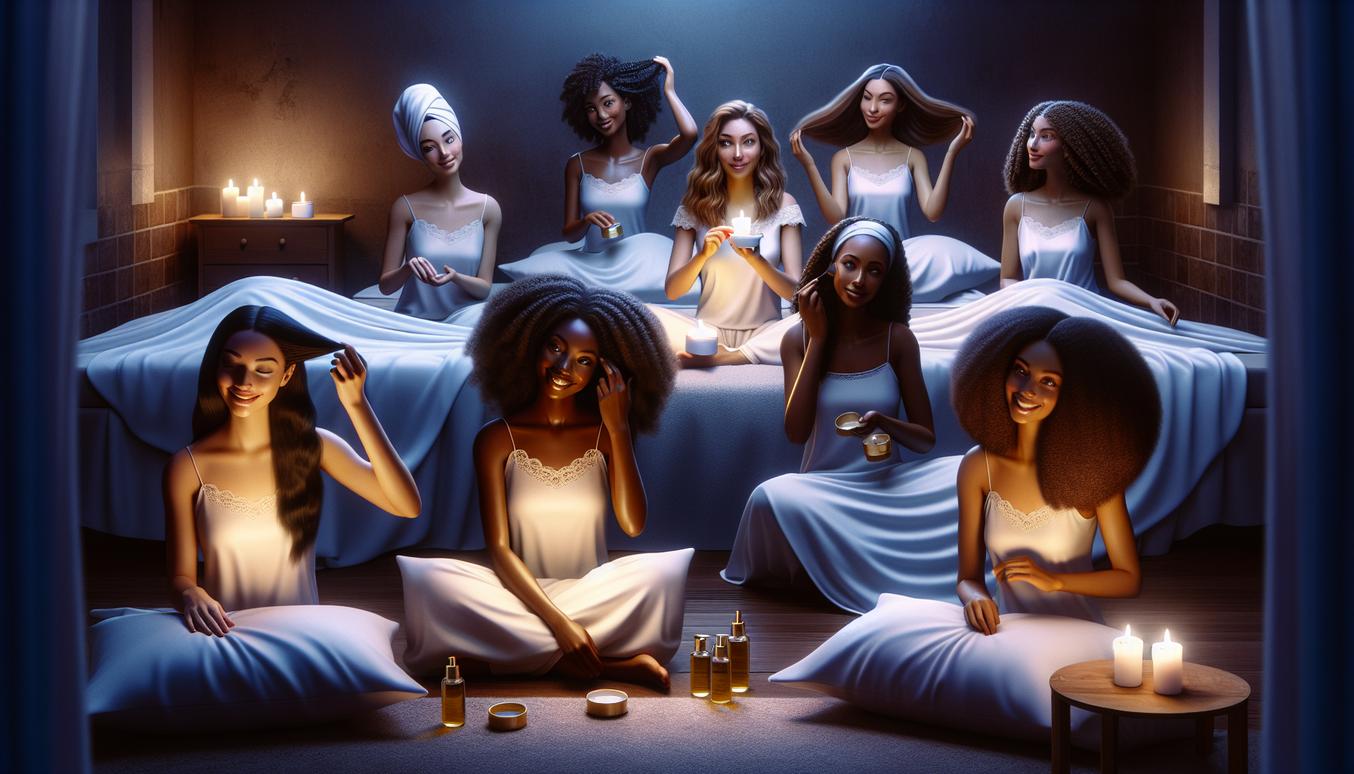Table of Contents
- Why Your Overnight Hair Care Routine is a Game-Changer
- Your Evening Checklist: 10 Minutes to Healthier Hair
- Night Routines by Hair Texture for 2025 and Beyond
- DIY Overnight Treatments and Gentle Recipes
- Protective Styles and How to Sleep in Them
- Best Fabrics and Tools for Sleep-Friendly Hair Care
- Ingredients to Avoid in Your Nightly Routine
- Weekly Deep-Rest Routines and Troubleshooting
- Quick Guidance: Choosing Multi-Use Items
- Common Questions About Overnight Hair Care
- Conclusion: Building Your Flexible 30-Day Plan
- References and Further Reading
Why Your Overnight Hair Care Routine is a Game-Changer
You have a skincare routine for the night, but what about your hair? While you rest, your hair is vulnerable to friction, tangling, and moisture loss. Waking up to a “bedhead” isn’t just an inconvenience; it’s a sign of nighttime damage. An effective overnight hair care routine is your secret weapon for healthier, more manageable hair with minimal morning effort. It’s not about adding complicated steps; it’s about making small, intentional adjustments that yield significant results.
How Hair Regenerates While You Sleep (Simple Science)
Just like your skin, your scalp and hair go into repair mode overnight. Your body’s circadian rhythm influences cell regeneration and the production of sebum, your scalp’s natural oil. This is prime time for your hair to absorb nutrients and recover from daily stressors like pollution and styling. However, tossing and turning on a standard cotton pillowcase creates friction that lifts the hair’s outer layer, the cuticle. This leads to frizz, breakage, and moisture loss. A smart overnight hair care strategy minimizes this damage and maximizes the natural repair process, helping you wake up with smoother, stronger strands.
Your Evening Checklist: 10 Minutes to Healthier Hair
Transforming your hair’s health doesn’t require a huge time commitment. This simple, 10-minute checklist can become a calming end-of-day ritual.
- Gentle Detangling (3 minutes): Always detangle your hair before bed. Start from the ends and work your way up to the roots using a wide-tooth comb or your fingers. This prevents small tangles from turning into major knots overnight.
- Light Hydration (2 minutes): Depending on your hair type, apply a pea-sized amount of a lightweight leave-in conditioner or a few drops of a natural oil (like argan or jojoba) to your mid-lengths and ends. This helps seal in moisture.
- Scalp Massage (3 minutes): Using the pads of your fingers, gently massage your scalp in circular motions. This stimulates blood flow, which can promote healthy growth and feels incredibly relaxing.
- Secure Your Style (2 minutes): Loosely secure your hair in a protective style, such as a braid or a high bun. This is a crucial step in any overnight hair care plan to reduce friction.
Night Routines by Hair Texture for 2025 and Beyond
Your hair’s texture dictates its needs. Here are tailored routines to protect your specific hair type while you sleep.
Straight and Fine Hair: Gentle Nightly Habits
The main goals for fine hair are to prevent oiliness at the roots and avoid tangles without weighing strands down.
- Combat Oil: If your hair gets greasy quickly, a light spritz of dry shampoo at the roots before bed can absorb excess sebum overnight.
- Prevent Tangles: A loose, low braid secured with a silk scrunchie is ideal. It prevents matting and won’t create unwanted kinks.
- Protect Ends: Apply a single drop of a very lightweight oil, like grapeseed oil, to just the tips to prevent them from drying out.
Wavy Hair: Maintaining Pattern and Moisture
For wavy hair, the challenge is to preserve your natural pattern and combat frizz without disrupting the waves.
- The “Pineapple”: Loosely gather your hair into a high ponytail on top of your head, secured with a gentle tie. This protects your wave pattern from being crushed while you sleep.
- Refresh and Hydrate: Lightly mist your hair with a water-based leave-in spray or just plain water to replenish moisture. Scrunch gently to encourage your waves.
- Fabric Matters: Sleep on a silk or satin pillowcase or wrap your hair in a silk scarf to minimize frizz-inducing friction.
Curly and Coily Hair: Preserving Definition and Reducing Breakage
Moisture retention and definition are the top priorities for a curly and coily overnight hair care routine.
- Protect the Curls: The “pineapple” method is also excellent for curls. For extra protection, cover your pineapple with a satin bonnet or scarf. This is a non-negotiable step to reduce breakage.
- Seal the Ends: Apply a small amount of a nourishing cream or oil to your ends to lock in moisture and protect them from friction.
- Nightly Refresh (Optional): If your curls feel dry, lightly spritz them with a mix of water and a few drops of conditioner before securing them for the night.
Color-Treated and Chemically Processed Hair: Nighttime Care Tips
Processed hair is more porous and prone to damage, so it needs extra TLC.
- Focus on Moisture: Use a color-safe, bond-repairing leave-in treatment or serum nightly to strengthen weakened strands.
- Reduce Friction at All Costs: A satin bonnet or pillowcase is essential to prevent cuticle damage that can lead to color fading and frizz.
- Gentle Styling: Opt for a loose bun or twists instead of a tight braid to avoid putting stress on fragile hair.
DIY Overnight Treatments and Gentle Recipes
You can give your hair a nourishing boost with simple, single-ingredient treatments. Remember to always perform a patch test before applying anything new to your scalp or hair.
- Aloe Vera Gel: Apply pure aloe vera gel to your scalp and hair for a soothing, hydrating mask. It’s lightweight and easily washes out in the morning.
- Jojoba Oil on Ends: Jojoba oil is structurally similar to your scalp’s natural sebum. Apply a few drops to your ends to seal split ends and add shine without being overly greasy.
- Rosewater Mist: A simple spritz of rosewater can help balance your scalp’s pH and add a touch of moisture and a pleasant scent before bed.
Protective Styles and How to Sleep in Them
A protective style is any hairstyle that tucks away the ends of your hair, protecting them from damage caused by friction and tangling. They are a cornerstone of a good overnight hair care routine.
- Loose Braid: A classic choice for long hair. A single low braid or two pigtail braids prevent tangles. Keep it loose to avoid tension on the scalp.
- High Bun (The “Pineapple”): Ideal for wavy and curly types, this involves gathering hair loosely at the crown of your head to protect the hair’s texture.
- Twists: Two-strand twists are a great way to protect hair while also creating a beautiful wave pattern for the next day.
Best Fabrics and Tools for Sleep-Friendly Hair Care
The surfaces your hair touches overnight matter. Investing in the right tools is a simple yet powerful step.
| Item | Benefit | Best For |
|---|---|---|
| Silk or Satin Pillowcase | Reduces friction, prevents moisture absorption, and minimizes hair breakage and frizz. | All hair types. |
| Satin or Silk Bonnet/Scarf | Provides maximum protection by fully enclosing hair, preserving styles, and locking in moisture. | Curly, coily, and processed hair. |
| Scrunchies (Silk or Satin) | Secures hair without the creasing or breakage caused by traditional elastic ties. | All hair types. |
| Wide-Tooth Comb | Gently detangles hair without pulling or snagging, especially when hair is dry. | All hair types. |
Ingredients to Avoid in Your Nightly Routine
What you don’t put on your hair is as important as what you do. Avoid these ingredients in your overnight products to prevent buildup and dryness.
- Heavy Silicones: Ingredients like dimethicone can create buildup, weigh hair down, and prevent moisture from penetrating the hair shaft.
- Drying Alcohols: Avoid products with high concentrations of SD alcohol, denatured alcohol, or isopropyl alcohol, as they can strip hair of its natural moisture.
- Heavy Butters or Petrolatum on the Scalp: While great for sealing ends, applying these to the scalp can clog follicles and lead to buildup.
Weekly Deep-Rest Routines and Troubleshooting
Once a week, enhance your overnight hair care with a deeper treatment. Apply a nourishing hair mask or a heavier oil treatment, cover with a shower cap and a bonnet, and wash it out in the morning. This is a great way to deeply condition and repair your hair.
Troubleshooting Common Issues
- “My hair feels greasy in the morning.” You might be using too much product or applying it too close to your roots. Use a pea-sized amount and focus only on the mid-lengths and ends.
- “My style fell flat.” Your protective style might have been too loose. For curls and waves, ensure your pineapple or bonnet is secure but not tight. For straight hair, a slightly firmer (but still gentle) braid may help.
Quick Guidance: Choosing Multi-Use Items
To keep your routine simple and cost-effective, look for versatile items. A good water-based leave-in conditioner can act as a detangler, moisturizer, and curl refresher. A high-quality natural oil like argan or jojoba can be used to seal ends, tame flyaways, and even as a pre-shampoo treatment. The goal is to find a few hardworking staples rather than a dozen different products.
Common Questions About Overnight Hair Care
Is it bad to sleep with wet hair?
Yes, it’s best to avoid it. Hair is at its most fragile when wet, making it highly susceptible to breakage. The friction against your pillow can cause significant damage. If you must wash your hair at night, try to let it air-dry at least 80% of the way before going to bed.
Is a bonnet better than a silk pillowcase?
It depends on your hair type and goals. A pillowcase is great for everyone and reduces friction on your skin as well. A bonnet offers 360-degree protection, which is superior for preserving intricate styles and for very dry or curly hair that needs to retain maximum moisture.
How often should I do an overnight hair mask?
For most hair types, a deep conditioning overnight treatment once a week is sufficient. If your hair is extremely damaged or dry, you might increase this to twice a week, but listen to your hair—if it starts to feel limp or over-moisturized, scale back.
Conclusion: Building Your Flexible 30-Day Plan
Embracing overnight hair care is about consistency, not complexity. Start small. For the next 30 days, commit to a simple 10-minute routine based on your hair type. Choose one or two strategies—like switching to a silk pillowcase and putting your hair in a loose braid—and stick with them. Pay attention to how your hair looks and feels in the morning. You’ll likely notice less frizz, fewer tangles, and improved softness. Your journey to healthier hair can happen while you sleep, proving that great hair care doesn’t have to be a chore.





